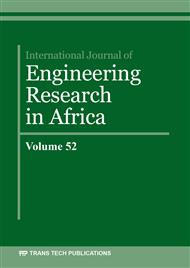[1]
Mpofu, F., Ochieng, E. G., Moobela, C., and Pretorius A., Profiling causative factors leading to construction project delays in the United Arab Emirates, Engineering, Con-struction and Architectural Management, 24 (2017) 346-376.
DOI: 10.1108/ecam-05-2015-0072
Google Scholar
[2]
Bajjou, M. S., and Chafi, A., Towards Implementing Lean Construction in the Moroc-can Construction Industry : Survey Study. In 2018 4th International Conference on Optimization and Applications (ICOA), IEEE, EL Mohammadiya, Morocco, pp.1-5 (2018).
DOI: 10.1109/icoa.2018.8370556
Google Scholar
[3]
Bagaya O., and Song, J., Empirical Study of Factors Influencing Schedule Delays of Public Construction Projects in Burkina Faso, Journal of Management in Engineering, 32 (2016) 05016014.
DOI: 10.1061/(asce)me.1943-5479.0000443
Google Scholar
[4]
Larsen, J. K., Shen, G. Q, Lindhard, S. M., and Brunoe, T. D., Factors Affecting Schedule Delay, Cost Overrun, and Quality Level in Public Construction Projects, Journal of Management in Engineering, 32 (2016) 04015032.
DOI: 10.1061/(asce)me.1943-5479.0000391
Google Scholar
[5]
Bajjou, M. S., and Chafi, A., Empirical study of schedule delay in Moroccan construc-tion projects, International Journal of Construction Management, 20 (2020) 783-800.
DOI: 10.1080/15623599.2018.1484859
Google Scholar
[6]
Bajjou M. S., Chafi, A., and Ennadi, A., Development of a Conceptual Framework of Lean Construction Principles : An Input-Output Model, Journal of Advanced Man-ufacturing Systems, 18 (2019) 1–34.
DOI: 10.1142/s021968671950001x
Google Scholar
[7]
Abbasian-Hosseini, S. A., Nikakhtar, A., and Ghoddousi, P., Verification of lean con-struction benefits through simulation modeling: A case study of bricklaying process, KSCE Journal of Civil Engineering, 18 (2014) 1248–1260.
DOI: 10.1007/s12205-014-0305-9
Google Scholar
[8]
Bajjou M. S., Chafi, A., Lean construction and simulation for performance improve-ment: a case study of reinforcement process, International Journal of Productivity and Performance Management, Vol. ahead-of-print No. ahead-of-print. https://doi.org/10.1108/IJPPM-06-2019-0309.
DOI: 10.1108/ijppm-06-2019-0309
Google Scholar
[9]
Bajjou M. S., Chafi, A., Assessing the Critical Sources of Wastes in the Moroccan Construction Industry, In Proceedings of the 3rd International Conference on Smart City Applications, ACM, Tetouan, Morocco, pp.1-5 (2018).
DOI: 10.1145/3286606.3286783
Google Scholar
[10]
Bajjou, M.S., Chafi, A., Identifying and Managing Critical Waste Factors for Lean Construction Projects, Engineering Management Journal. 32 (2020) 2–13.
DOI: 10.1080/10429247.2019.1656479
Google Scholar
[11]
Abbasian Hosseini, S. A., Nikakhtar, A., and Ghoddousi, P., Flow Production of Construction Processes through Implementing Lean Construction Principles and Simu-lation, International Journal of Engineering and Technology, 4 (2012) 475-479.
DOI: 10.7763/ijet.2012.v4.414
Google Scholar
[12]
Nikakhtar, A., Hosseini, A. A., Wong, K. Y., and Zavichi, A., Application of lean con-struction principles to reduce construction process waste using computer simulation: a case study, International Journal of Services and Operations Management, 20 (2015) 461-480.
DOI: 10.1504/ijsom.2015.068528
Google Scholar
[13]
Koskela, L., Management of production in construction: a theoretical view, Proc. IGLC-7, Berkeley, CA, USA, p.241–252 (1999).
Google Scholar
[14]
Gao, S., and Low, S. P., Lean Construction Management. The Toyota Way. Springer. Singapur (2014).
Google Scholar
[15]
Bajjou M. S., Chafi, A., A conceptual model of lean construction: a theoretical framework. Malaysian Construction Research Journal, 26 (2018) 67-87.
Google Scholar
[16]
Bajjou M. S., Chafi, A., The professionals' perception on the main causes of wastes in the Moroccan construction industry, In Proceedings of the 3rd International Confer-ence on Smart City Applications, ACM, Tetouan, Morocco, pp.1-4 (2018).
DOI: 10.1145/3286606.3286785
Google Scholar
[17]
Bajjou M. S., Chafi, A. The potential effectiveness of lean construction principles in reducing construction process waste: An input-output model, Journal of Mechanical Engineering and Sciences, 12 (2018) 4141-4160.
DOI: 10.15282/jmes.12.4.2018.12.0358
Google Scholar
[18]
Tezel, A., Koskela, L., and Aziz, Z., Lean thinking in the highways construction sec-tor: motivation, implementation and barriers, Production Planning & Control, 29 247–(2018) 269.
DOI: 10.1080/09537287.2017.1412522
Google Scholar
[19]
Chouiraf, F., and Chafi, A., Adaptation of the Value Stream Mapping (VSM) For the Moroccan Artisanal Enterprise. In 2018 IEEE 5th International Congress on Infor-mation Science and Technology (CiSt), IEEE, Marrakesh, Morocco, pp.1-6 (2018).
DOI: 10.1109/cist.2018.8596624
Google Scholar
[20]
Abdulmalek, F. A., and Rajgopal, J., Analyzing the benefits of lean manufacturing and value stream mapping via simulation: A process sector case study, International Journal of production economics, 107 (2007) 223-236.
DOI: 10.1016/j.ijpe.2006.09.009
Google Scholar
[21]
Neeraj, A., Rybkowski, Z., Fernandez-Solis, J.L., Hill, R., Tsao, C., Seed, B., and Heinemeier, D., Framework linking lean simulation principles to their application on construction projects. In Proceedings 24th Annual Conference of the International Group for Lean Construction, Boston, MA, pp.3-12 (2016).
DOI: 10.24928/2018/0463
Google Scholar
[22]
Al-Sudairi, A., and Diekmann, J., Simulation of construction processes: traditional practices versus lean principles, In Seventh Conference of the International Group for Lean Construction, Berkeley, CA, USA, p.39 (1999).
Google Scholar
[23]
Hassan M. M., and Gruber, S., Simulation of Concrete Paving Operations on Inter-state-74, ournal of Construction Engineering and Management, 134 (2018) 2-9.
Google Scholar
[24]
Mao X., and Zhang, X., Construction Process Reengineering by Integrating Lean Prin-ciples and Computer Simulation Techniques, Journal of construction Engineering and Management, 134 (2018) 371–381.
DOI: 10.1061/(asce)0733-9364(2008)134:5(371)
Google Scholar
[25]
Sawhney, A., Abourizk, S. M., and Halpin, D. W., Construction project simulation us-ing CYCLONE, Canadian Journal of Civil Engineering, 2516-25 (1998).
DOI: 10.1139/l97-047
Google Scholar
[26]
Kamrani, M., Hashemi Esmaeil Abadi, S. M., and Rahimpour Golroudbary, S., Traffic simulation of two adjacent unsignalized T-junctions during rush hours using Arena software, Simulation Modelling Practice and Theory, 49 (2015 ) 167-179.
DOI: 10.1016/j.simpat.2014.09.006
Google Scholar
[27]
Toledo, T., Koutsopoulos, H.N., Davol, A., Ben-Akiva, M.E., Burghout, W., Andréas-so, I., and Lundin, T,. Calibration and Validation of Microscopic Traffic Simulation Tools: Stockholm Case Study, Transportation Research Record. 1831 (2007) 65-75.
DOI: 10.3141/1831-08
Google Scholar
[28]
Nikakhtar, A., Hosseini, A. A., and Wong, K. Y., Sensitivity Analysis of Construction Processes Using Computer Simulation : A Case Study, Advanced Science Letters, 13 (2012) 680-684.
DOI: 10.1166/asl.2012.3923
Google Scholar
[29]
Farrar, J., AbouRizk, S., and Mao, X., Generic implementation of lean concepts in simulation models, Lean Construction Journal, 1 (2014) 1-23.
Google Scholar
[30]
Banks, J., Carson, I. I., Nelson, B. L., and Nicol, D. M. Discrete-Event System Simula-tion, Pearson (2014).
Google Scholar


